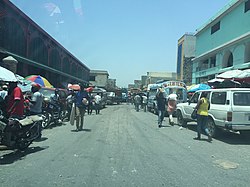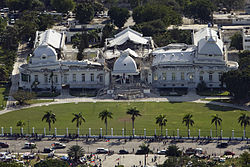Port-au-Prince
Port-au-Prince (Pòtoprens in Kreyòl) is the capital city of Haiti. Haiti is also divided into ten Départements; Port-au-Prince is the capital of the Ouest Département.[1]
|
(Kreyòl): Pòtoprens | |
|---|---|
 | |
| Coordinates: Coordinates: 18°32′21″N 72°20′06″W / 18.53917°N 72.33500°W | |
| Country | Haiti |
| Département | Ouest |
| Arrondisement | Port-au-Prince |
| Founded | 1749 |
| Colonial seat | 1770 |
| Elevation | 98 m (322 ft) |
| Population (2007) | |
| • City | 1,082,800 |
| • Metro | 1,728,100 |
| • Demonym | Port-au-Princien (female Port-au-Princienne) |
| Time zone | UTC-5 (Eastern) |
| • Summer (DST) | UTC-4 (Eastern) |
Port-au-Prince is Haiti's largest city. According to the country's 2015 census, over 2.6 million people lived there.[1]
History
Port-au-Prince was built in 1749. At that time, Haiti was a French colony called Saint-Domingue. Before 1770, Cap-Français (now Cap-Haïtien) was the capital of Saint-Domingue. In 1770, Port-au-Prince replaced Cap-Français as the capital of Saint-Domingue.[2]
In 1804, the people of Haiti won the Haitian Revolution, and Haiti became an independent country.[3] Port-au-Prince became the capital of this new country. During the French and Haitian Revolutions, it was called Port-Républicain, before Jean-Jacques Dessalines renamed it Port-au-Prince.[4]
Shortly after it won its independence, Haiti's new leaders divided the country between a kingdom in the north and a republic in the south. Port-au-Prince remained the capital of the republic.[5]
Port-au-Prince today
Port-au-Prince is the cultural centre of Haiti. The State University of Haiti (L'Université d'État d'Haïti, or UEH, in French);[6] the Université Quisqueya;[7] and the Université Caraïbe[8] are all located in the city.
Port-au-Prince is the nation's largest centre of economy and finance. It has the most important port in the country, where coffee and sugar are exported. Port-au-Prince has soap, textile, and cement factories, and others to process foods.
There is also an international airport about 10 kilometres (6.2 miles) north of the city. It is named Aéroport International Toussaint L'ouverture after national hero Toussaint L'ouverture.[9]
The city was very badly damaged and more than 100,000 people died in the 2010 Haiti earthquake, which is one of the deadliest earthquakes in history. Due to extreme poverty, the city has still not recovered from the earthquake, and many ruins still remain.
Port-au-Prince Media
City of Port-au-Prince as viewed by NASA
Map of Hispaniola and Puerto Rico, c. 1639.
The Presidential Palace (National Palace) on 13 January 2010, the day after the 2010 earthquake, showing the extensive damage to the edifice.
City and bay views from the terrace of the Hôtel Montana in Pétion-Ville
References
- ↑ 1.0 1.1 Institut Haïtien de Statistique et d’Informatique (March 2015). Population Totale, de 18 Ans et Plus: Ménages et Densités Estimés en 2015 (Report) (in French). Ministère de l’Économie et des Finances (MEF), République d’Haïti. pp. 16, 23.
{{cite report}}: CS1 maint: unrecognized language (link) - ↑ Geggus, David (1991). "The Major Port Towns of Saint Domingue in the Later Eighteenth Century". Atlantic Port Cities: Economy, Culture, and Society in the Atlantic World, 1650–1850. University of Tennessee Press. pp. 87-116. ISBN 978-0870496578.
- ↑ Taber, Robert D. (2015). "Navigating Haiti's History: Saint-Domingue and the Haitian Revolution". History Compass. 13 (5): 235–50. doi:10.1111/hic3.12233.
- ↑ "Haiti: Miscellaneous Collections" (PDF). Schomburg Center for Research in Black Culture. The New York Public Library. p. 5. Retrieved May 29, 2016.
- ↑ "The Haitian Revolution". Encyclopædia Britannica Online. Encyclopædia Britannica Inc. 2016. Retrieved May 29, 2016.
- ↑ "Bienvenue". L'Université d'État d'Haïti (in français). Archived from the original on November 2, 2021. Retrieved May 29, 2016.
- ↑ "Bienvenue à l'Université Quisqueya". Université Quisqueya. Retrieved May 29, 2016.
- ↑ "Acceuil". Université Caraïbe. Archived from the original on March 24, 2016. Retrieved May 29, 2016.
- ↑ "Toussaint Louverture Intl". World Aero Data. Digital Aeronautical Flight Information File. 2016. Archived from the original on March 3, 2016. Retrieved May 29, 2016.
| Department capitals of Haiti | |
|---|---|
| Cap-Haïtien • Fort-Liberté • Gonaïves • Hinche • Jacmel • Jérémie • Les Cayes • Miragoâne • Port-au-Prince • Port-de-Paix | |
| Wikimedia Commons has media related to Lua error in Module:Commons_link at line 62: attempt to index field 'wikibase' (a nil value).. |










